what skills do you need to be a blacksmith
150 years ago most census records showed that a 5th of the respondents listed their occupation as blacksmith, including my 3rd bully-granddad, Roger Farrer. I don't know what Grampa Farrer fabricated every day, but if he was like most smiths, he was making everything. Horseshoes were a small role of the job. He was more likely fabricating or repairing a farm implement, making hardware like hinges or pulleys, or fifty-fifty something every bit mundane as nails. The box of nails nosotros purchase at the hardware shop for a few dollars were once made one at a time–by hand.Visit a living history site and there will be a crowd around the blacksmith. It pulls people in…How does he do that?
The methods Grampa Farrer used are essentially unchanged. I call them the Three Hs: Heating, Holding and Hitting.
Since about people don't know a blacksmith, I get a lot of questions about the trade. Even strangers walking past my shop (the half of my garage) stop at the sound of hammers on steel and sheepishly look for me to see them since I'thousand wearing hearing protection. I usually stop and respond questions, specially if there are children in the grouping.
"Where's the coal?"
Many blacksmiths withal utilise coal, and at that place are good reasons for it. You can get fast heats, and a skilled smith can dispense the heat along a long piece of steel. The downside is that coal's dirty, which is fine if you have a detached store. I use propane considering it's clean, relatively inexpensive, and the neighbors downwind don't need respirators.
"Where do y'all become steel?"
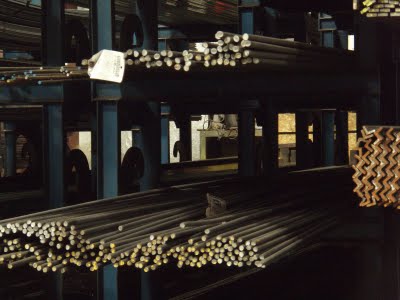
From a steelyard. We have lumberyards for lumber, and steelyards for steel. While lumberyards are fairly common in most places, steelyards are harder to find equally they rarely cater to the public at large, mostly because no ane in the public at large wants a 20' piece of hot-rolled 5/8" diameter A36 steel rod. They're commonly found in industrial parks and such. Mine is a family unit-owned quaternary-generation business, and they're wonderfully kind to a guy who spends little money there compared to the trucker loading a flatbed with tons of steel tubing.
"How hot does information technology get?"
Very hot. 1400 degrees, big F. I can make it hotter or colder, just I commonly go on it correct around in that location. Welding oestrus and tool steel can require more oestrus.
Then there's the statement: "I bet information technology feels really expert to pound out all your frustrations…"
No, indeed. Hitting hard is function of the equation, simply hit accurately is more important. If a blacksmith is frustrated, he oughta go punch a bag until he gets over it, then become work at the anvil. More on that later.
Below I discuss the very basics of getting started in blacksmithing. You probably won't be able to offset blacksmithing correct after reading this, but hopefully information technology will pique your interest plenty to look more into this manly skill and trade. First, we'll take a look at the basic tools y'all need to get started with blacksmithing. We'll stop past showing yous the three fundamental means of hitting hot metallic in social club to shape it.
The Tools
Y'all need four basic things: A affair to rut your work, a thing to concur your work, a affair to put under your work, and a thing to apply forces to your work.
A Thing to Heat Your Piece of work
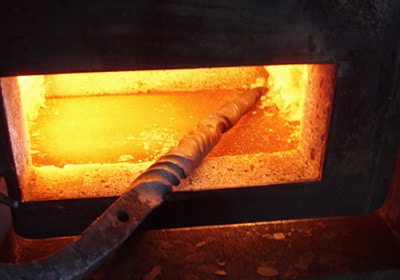
Here'south my small forge.
You heat your work with a forge. Forges need fuel and air, and lots of it. Whether it's a coke forge (coke is a material made from coal) with bellows or a propane forge with a fan, the basic idea is to apply heat to a slice of metal. Propane allows a little more control, although a primary blacksmith can make a coke forge heat the work to a perfect temperature. Many (similar me) use propane for its convenience and cleanliness.
You can exercise a lot with a smaller forge. It wastes less free energy and heats more quickly. A coke forge has an advantage here as it can be scaled easily, making the fire larger or smaller depending upon your work.
A blacksmith from the 18th century would take killed for an acetylene torch. The techniques for applying heat in small areas with a forge required astonishing skills and several assistants helping to position and cool the work where heat wasn't wanted. A good torch, both for cut and for heating, is critical. The rosebud tip on my acetylene torch puts out 40,000 BTUs. For reference, our furnace puts out 60,000 to heat our unabridged house. Then yes…a lot of rut in a small infinite. That makes isolating decorative twists in metal much easier.
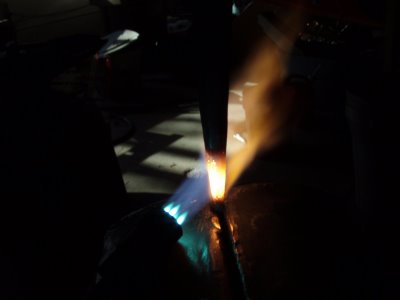
An acetylene torch in activeness. I'm heating the metallic with the torch to make a twist.
A Matter to Concord Your Work
You hold things with tongs, vises, or clamps. As my dear mentor Larry says, "If you can't hold it, yous can't hitting it." Tongs are main, and a good smithy (the identify a blacksmith works) has many tongs for property various shapes. A tong that's good for a ½" foursquare rod will fail if you try to hold a ¼" round rod. Property a flat piece of stock requires a dissimilar tong.
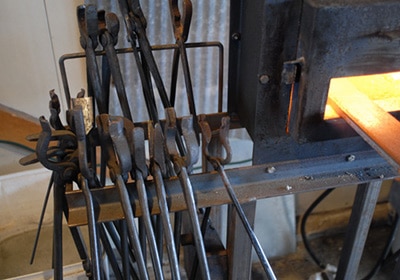
Different kinds of tongs for holding dissimilar shapes of metal.
A good vise is a godsend. If you buy a vise at Domicile Depot, I guarantee it would disintegrate inside five minutes of the corruption I pile upon my Welton. Tools are not cheap, nor should they exist. In this example, I'm holding an water ice chisel made for a friend.
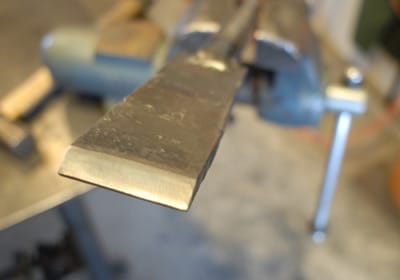
Clamps are likewise critical, especially if welding something that needs to be squared and apartment. Holding something foursquare or flat is tough without a big, stable surface and a method to stabilize it.
A Thing to Put Nether Your Work
The something under the work is ordinarily the anvil. A skilful anvil is critical to successful work. In that location are $200 anvils out there, and they're practiced for boat anchors or something to be dropped on roadrunners.
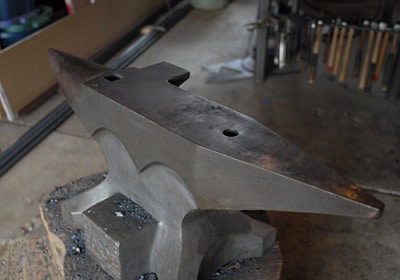 My anvil toll the most of whatever tool I have except my Miller 251 welder, and it was a close 1 on that. American-forged, the Rat Hole is a fantastically designed tool. It has two holes on it, the pritchel and the hardy (sometimes hardie) hole.
My anvil toll the most of whatever tool I have except my Miller 251 welder, and it was a close 1 on that. American-forged, the Rat Hole is a fantastically designed tool. It has two holes on it, the pritchel and the hardy (sometimes hardie) hole.
A pritchel is used for punching through a piece of metal, as yous demand a place for the slug to become when you get through the piece of work. It stabilizes the principal piece of piece of work and so information technology doesn't distort likewise much when yous showtime punching.
The hardy holds a number of cool tools like a Five-block, useful for putting a curve in a piece of stock, like making the curvature of a foliage, etc. Information technology can hold a swage for putting an edge on a piece of stock or making a notch in a piece of flat stock.
There is an upsetting block on the back side (a very prissy feature) and of course, the horn, which is the pointy part used for curving metal.
A Thing to Hitting Your Work
We're talking hammers here. Yous can skimp on tools in different places, and you'll ever be sorry, but that'southward doubly true with hammers and anvils. The variety of shapes, weights and head styles volition go obvious shortly.
There are many more tools that brand life easier and more productive, merely this is an introduction. More technical stuff will come up down the route, similar power hammers. I dearest/lust power hammers.
Shaping Metal
When working with hot steel, the best analogy I've used is that metal becomes a lot similar dirt when heated. Your chore is to shape it like you would clay. To make things long and skinny, you can take hold of a piece of dirt and stretch information technology, and it just breaks. Unfortunately, it takes a bit more work than that to stretch a piece of metallic. Steel is not Silly Putty.
You use basic forces to move your metallic. To make a long, skinny piece out of a short fatty piece, you lot squeeze the sides of the metallic, and plow the piece of work. If you accept a foursquare of dirt and squeeze it on the four sides repeatedly, it eventually becomes a long, thin polygon.
At that place are iii fundamental ways to utilise force (once more, in that location are more, merely we're keeping it elementary).
Drawing Out. This is the basic idea behind the cube of clay. Hitting the metal on four sides again and again and it draws out into a longer slice. One of the quintessential applications of this is to brand a nail indicate, where you create a iv-sided pyramid past repeatedly hitting and turning your work, but using the hammer to angle the tip rather than hit it flat. This is how former blacksmiths made their nails.
Upsetting. This is applying strength to the end of a piece of work to "mushroom" the metal out to add book to a piece. If you're making a piece that needs some heft on an end, like a broad chisel, y'all use upsetting.
Peining. This is applying force to move the metal in a certain direction. You tin move the metal in i direction or yous tin spread it in all directions. If yous karate chop a slice of dirt, it spreads out away from your hand parallel to the centrality of your hand. If you take a fist and hitting it, it spreads out in all directions.
The picayune ball on the dorsum of your hammer is called a brawl-pein. Information technology's designed to move metal out in all directions. See? Useful. I utilise a small ball-pein hammer for riveting through 2 pieces of metal to necktie them together. The picayune mushroom you see on a metal rivet is the result of a ball-pein.
There are other types of peins, like a cross-pein, to spread metal out on one centrality–like karate chopping that piece of clay. If I am making a leaf on a piece of stock, I volition frequently cross-pein it to requite the leaf more width. Willow leaf: not cross-peined. Aspen leafage: cross-peined.
Permit's utilize some of these simple forces. Hither are a few examples.
Drawing Out:
We start with a piece of three/8″ foursquare stock. Get it hot.
First, we upset using a apartment hammer, a pretty heavy one, 1000g, or 2.2 pounds. The larger the hammer, the greater the force applied per hit. Sledges will make short work of a small piece. Drib a ten pound weight on a piece of clay: squish. I calibration the hammer to the work size.
We'll create a smash point by drawing out.
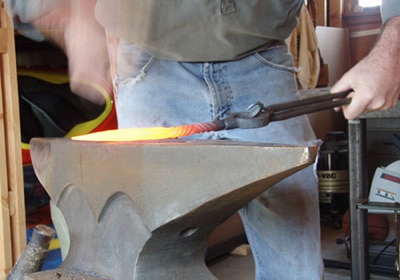 I had already put a twist in the work: ignore it for now. I work at the edge of the anvil hither, to allow me to put a fine point on the piece of work. I and so turned the work 45 degrees and put another border to make an octagon. Take the edges off the octagon and you have 16 edges. Go on, and y'all have a cone, but hither I left edges to accentuate the twisting.
I had already put a twist in the work: ignore it for now. I work at the edge of the anvil hither, to allow me to put a fine point on the piece of work. I and so turned the work 45 degrees and put another border to make an octagon. Take the edges off the octagon and you have 16 edges. Go on, and y'all have a cone, but hither I left edges to accentuate the twisting.
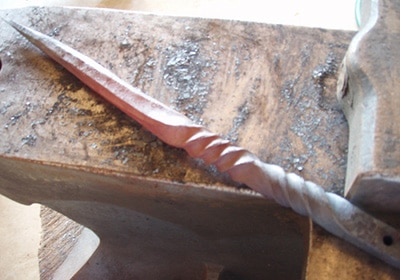 Information technology takes multiple heats sometimes, meaning y'all'll accept to re-heat the metallic in the forge so you can keep shaping information technology. Don't hit the work when it's cold…it tin can create a common cold shunt that weakens the work. A common cold shunt is where the hot and cold parts shear and create a weak spot. That's no bueno.
Information technology takes multiple heats sometimes, meaning y'all'll accept to re-heat the metallic in the forge so you can keep shaping information technology. Don't hit the work when it's cold…it tin can create a common cold shunt that weakens the work. A common cold shunt is where the hot and cold parts shear and create a weak spot. That's no bueno.
Upsetting:
This is where nosotros add volume to an terminate to offset something similar a chisel. Information technology's a little tougher because tool steel requires more oestrus and is harder at lower temps. Simply using the weight of the piece works quite well. You lot can also upset at the edge of the anvil, driving metallic back toward yourself. Small, non huge hits move metal better and under more control. Meet how information technology'south starting to mushroom out?
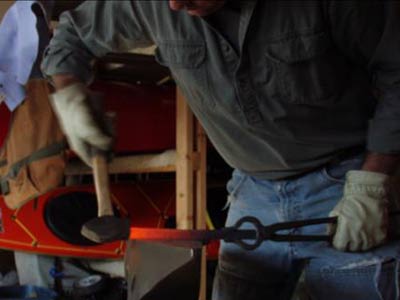
Peining:
Here I'g spreading the ends of a piece of stock to make a set of drawer pulls for my married woman. A lot of the pall rods, drawer pulls, and candlesticks in my house were made in the shop, and she wanted to have some pulls for the bathroom. I used a ball-pein hither to move the metal, then smoothed it out with the flat face up of a hammer.
 Then I ringlet over the edge, put a few bends in the piece of work and voila, drawer pull.
Then I ringlet over the edge, put a few bends in the piece of work and voila, drawer pull.
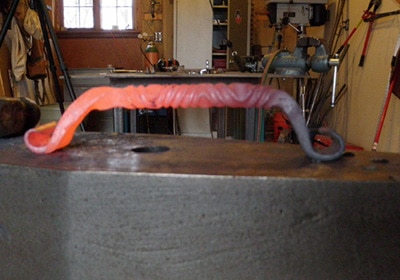 —
—
A few other notes:
The essence of blacksmithing is not then much strength as control. Yes, you lot need to "get it hot and hit it difficult" sometimes, especially with larger work, but the play a trick on is to hit the metallic where you want, equally hard every bit you desire as accurately as you want. When I first started working with metallic more a decade ago, my mentor drew an Ten on the anvil. "Hit there, move your work." Chasing your work will outcome in a ruined piece or at to the lowest degree some cut marks, acquired by hitting with the border of a hammer and not the face up.
There is a Zen-like beauty to having that sort of power and at the same time, that sort of control. Similar everything worthwhile, it comes with fourth dimension and practice. If your heed is cluttered, plow off the forge, clean your shop, and go back in the house. Clear heed means practiced work. I can tell when I make something if I was distracted. It goes in the fleck bucket for another day. Which leads me to…
There are no mistakes. Different woods, where you can cut it three times and it'southward yet too brusque, metal is recyclable. If a piece is botched, look and give it another chance.
I one time made a bulldoze hook, a combination nail and hook that log cabin dwellers used to hang upwardly their stuff. I realized when I had finished it that the blast was facing the claw. Worthless, I threw it on the ground and walked out into the cool nighttime air. I was beating myself up for a lack of mindfulness. My wise and loving mentor, Larry, walked outside and stood with me for a moment. "There are no mistakes," he said in his lovely Alabama drawl. We went inside, he heated the hook with a torch and gave information technology a few twists, ending with the blast pointing in the proper management. It was actually more than beautiful than the original.
There are no mistakes. And there are 2nd chances, in metallic and in men.
P.S. Some of the pictures hither show a mess. Ignore it, please. It's not e'er similar that. My store ends at the anvil.
P.P.S Like I said at the beginning, this was a very bones primer. I programme on following up with specifics in later on posts. That is, if you all are interested.
Previous Next
Source: https://www.artofmanliness.com/living/leisure/blacksmithing-primer/
0 Response to "what skills do you need to be a blacksmith"
Post a Comment